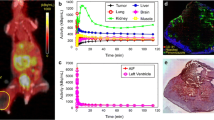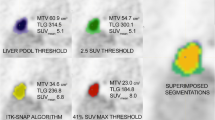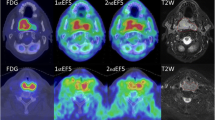Abstract
Purpose
Delineation of gross tumour volume in 3D is a critical step in the radiotherapy (RT) treatment planning for oropharyngeal cancer (OPC). Static [18F]-FDG PET/CT imaging has been suggested as a method to improve the reproducibility of tumour delineation, but it suffers from low specificity. We undertook this pilot study in which dynamic features in time-activity curves (TACs) of [18F]-FDG PET/CT images were applied to help the discrimination of tumour from inflammation and adjacent normal tissue.
Methods
Five patients with OPC underwent dynamic [18F]-FDG PET/CT imaging in treatment position. Voxel-by-voxel analysis was performed to evaluate seven dynamic features developed with the knowledge of differences in glucose metabolism in different tissue types and visual inspection of TACs. The Gaussian mixture model and K-means algorithms were used to evaluate the performance of the dynamic features in discriminating tumour voxels compared to the performance of standardized uptake values obtained from static imaging.
Results
Some dynamic features showed a trend towards discrimination of different metabolic areas but lack of consistency means that clinical application is not recommended based on these results alone.
Conclusions
Impact of inflammatory tissue remains a problem for volume delineation in RT of OPC, but a simple dynamic imaging protocol proved practicable and enabled simple data analysis techniques that show promise for complementing the information in static uptake values.




Similar content being viewed by others
References
Marur S, Burtness B (2014) Oropharyngeal squamous cell carcinoma treatment: current standards and future directions. Curr Opin Oncol 26:252–258
Lee MK, Nalliah RP, Kim MK, Elangovan S, Allareddy V, Kumar-Gajendrareddy P, Allareddy V (2011) Prevalence and impact of complications on outcomes in patients hospitalized for oral and oropharyngeal cancer treatment. Oral Surg Oral Med Oral Pathol Oral Radiol Endod 5:581–591
Nguyen NP, Vos P, Smith HJ, Nguyen PD, Alfieri A, Karlsson U, Dutta S, Lemanski C, Nguyen LM, Sallah S (2007) Concurrent chemoradiation for locally advanced oropharyngeal cancer. Am J Otolaryngol 28:3–8
Guido A, Fuccio L, Rombi B, Castellucci P, Cecconi A, Bunkheila F, Fuccio C, Spezi E, Angelini AL, Barbieri E (2009) Combined 18F-FDG-PET/CT imaging in radiotherapy target delineation for head-and-neck cancer. Int J Radiat Oncol Biol Phys 73:759–763
Minn H, Suilamo S, Seppälä J (2010) Impact of PET/CT on planning of radiotherapy in head and neck cancer. Q J Nucl Med Mol Imaging 54:521–532
Hammarstedt L, Lindquist D, Dahlstrand H, Romanitan M, Dahlgren LO, Joneberg J, Creson N, Lindholm J, Ye W, Dalianis T, Munck-Wikland E (2006) Human papillomavirus as a risk factor for the increase in incidence of tonsillar cancer. Int J Cancer 119:2620–2623
Attner P, Du J, Näsman A, Hammarstedt L, Ramqvist T, Lindholm J, Marklund L, Dalianis T, Munck-Wikland E (2010) The role of human papillomavirus in the increased incidence of base of tongue cancer. Int J Cancer 126:2879–2884
Chaturvedi AK, Engels EA, Pfeiffer RM, Hernandez BY, Xiao W, Kim E, Jiang B, Goodman MT, Sibug-Saber M, Cozen W, Liu L, Lynch CF, Wentzensen N, Jordan RC, Altekruse S, Anderson WF, Rosenberg PS, Gillison ML (2011) Human papillomavirus and rising oropharyngeal cancer incidence in the United States. J Clin Oncol 29:4294–4301
Ang KK, Harris J, Wheeler R, Weber R, Rosenthal DI, Nguyen-Tân PF, Westra WH, Chung CH, Jordan RC, Lu C, Kim H, Axelrod R, Silverman CC, Redmond KP, Gillison ML (2010) Human papillomavirus and survival of patients with oropharyngeal cancer. N Engl J Med 363:24–35
Dalianis T (2014) Human papillomavirus and oropharyngeal cancer, the epidemics, and significance of additional clinical biomarkers for prediction of response to therapy (Review). Int J Oncol 44:1799–1805
Masterson L, Moualed D, Liu ZW, Howard JE, Dwivedi RC, Tysome JR, Benson R, Sterling JC, Sudhoff H, Jani P, Goon PK (2014) De-escalation treatment protocols for human papillomavirus-associated oropharyngeal squamous cell carcinoma: a systematic review and meta-analysis of current clinical trials. Eur J Cancer 50:2636–2648
Metser U, Even-Sapir E (2007) Increased (18)F-fluorodeoxyglucose uptake in benign, nonphysiologic lesions found on whole-body positron emission tomography/computed tomography (PET/CT): accumulated data from four years of experience with PET/CT. Semin Nucl Med 37:206–222
Muzi M, O’Sullivan F, Mankoff DA, Doot RK, Pierce LA, Kurland BF, Linden HM, Kinahan PE (2012) Quantitative assessment of dynamic PET imaging data in cancer imaging. Magn Reson Imaging 30:1203–1215
Carlson ER, Schaefferkoetter J, Townsend D, McCoy JM, Campbell PD Jr, Long M (2013) The use of multiple time point dynamic positron emission tomography/computed tomography in patients with oral/head and neck cancer does not predictably identify metastatic lymph nodes. J Oral Maxillofac Surg 71:162–177
Lassen P, Primdahl H, Johansen J, Kristensen CA, Andersen E, Andersen LJ, Evensen JF, Eriksen JG, Overgaard J (2014) Impact of HPV-associated p16-expression on radiotherapy outcome in advanced oropharynx and non-oropharynx cancer. Radiother Oncol 113:310–316
Din M (2014) Differentiation of metabolically distinct areas within head and neck region using dynamic 18F-FDG positron emission tomography imaging. Masters Thesis, University of Turku, available on-line http://urn.fi/URN:NBN:fi-fe201401281303
Ang KK, Garden AS (2012) Radiotherapy for head and neck cancers: indications and techniques, 4th edition. Lippincott Williams & Wilkins, Philadelphia
Bonner JA, Harari PM, Giralt J, Azarnia N, Shin DM, Cohen RB, Jones CU, Sur R, Raben D, Jassem J, Ove R, Kies MS, Baselga J, Youssoufian H, Amellal N, Rowinsky EK, Ang KK (2006) Radiotherapy plus cetuximab for squamous-cell carcinoma of the head and neck. N Engl J Med 354:567–578
Maldonado A, González-Alenda FJ, Alonso M, Sierra JM (2007) PET-CT in clinical oncology. Clin Transl Oncol 9:494–505
Semenza GL (2010) HIF-1: upstream and downstream of cancer metabolism. Curr Opin Genet Dev 20:51–56
Simpson IA, Dwyer D, Malide D, Moley KH, Travis A, Vannucci SJ (2008) The facilitative glucose transporter GLUT3: 20 years of distinction. Am J Physiol Endocrinol Metab 295:E242–253
Calvo MB, Figueroa A, Pulido EG, Campelo RG, Aparicio LA (2010) Potential role of sugar transporters in cancer and their relationship with anticancer therapy. Int J Endocrinol 2010. doi:10.1155/2010/205357
Barger RL Jr, Nandalur KR (2012) Diagnostic performance of dual-time 18F-FDG PET in the diagnosis of pulmonary nodules: a meta-analysis. Acad Radiol 19:153–158
Schillaci O (2012) Use of dual-point fluorodeoxyglucose imaging to enhance sensitivity and specificity. Semin Nucl Med 42:267–280
Shen G, Deng H, Hu S, Jia Z (2014) Potential performance of dual-time-point 18F-FDG PET/CT compared with single-time-point imaging for differential diagnosis of metastatic lymph nodes: a meta-analysis. Nucl Med Commun 35:1003–1010
Tavares JM (2014) Analysis of biomedical images based on automated methods of image registration. In: Bebis G et al (eds) Advances in visual computing, 1st edn. Springer International Publishing, Cham, pp 21–30
Alves RS, Tavares JM (2015) Computer image registration techniques applied to nuclear medicine images. In: Tavares JM et al (eds) Computational and experimental biomedical sciences: methods and applications, 1st edn. Springer International Publishing, Cham, pp 173–191
Oliveira FP, Borges Faria D, Campos Costa D, Tavares JM (2014) A robust computational solution for automated quantification of a specific binding ratio based on [123I]FP-CIT SPECT images. Q J Nucl Med Mol Imaging 58:74–84
Ma Z, Tavares JM, Jorge RN, Mascarenhas T (2010) A review of algorithms for medical image segmentation and their applications to the female pelvic cavity. Comput Methods Biomech Biomed Eng 13:235–246
Shepherd T, Owenius R (2012) Gaussian process models of dynamic PET for functional volume definition in radiation oncology. IEEE Trans Med Imaging 31:1542–1556
Abgral R, Py Le Roux, Rousset J, Querellou S, Valette G, Nowak E, Turzo A, Tissot V, Marianowski R, Salaün PY (2013) Prognostic value of dual-time-point 18F-FDG PET/CT-imaging in patients with head and neck squamous cell carcinoma. Nucl Med Commun 34:551–556
Sakamoto H, Nakai Y, Ohashi Y, Okamura T, Ochi H (1997) Positron emission tomographic imaging of head and neck lesions. Eur Arch Otorhinolaryngol 254(Suppl1):S123–126
Minn H, Zasadny KR, Quint LE, Wahl RL (1995) Lung cancer: reproducibility of quantitative measurements for evaluating 2-[F-18]-fluoro-2-deoxy-D-glucose uptake at PET. Radiology 196:167–173
Acknowledgments
We thank Rikard Owenius, PhD for our ability to learn from each other in this and a related project. We also thank the staff at Turku PET Centre and the Department of Oncology and Radiotherapy in Turku University Hospital. This study was supported in part by the Cancer Foundation in Finland, Hospital District of Southwest Finland, and the National Graduate School of Clinical Investigation.
Author information
Authors and Affiliations
Corresponding author
Ethics declarations
Conflict of interest
Antti Silvoniemi, Mueez U Din, Sami Suilamo, Tony Shepherd and Heikki Minn declare that they have no conflict of interest.
Rights and permissions
About this article
Cite this article
Silvoniemi, A., Din, M.U., Suilamo, S. et al. Radiotherapy volume delineation using dynamic [18F]-FDG PET/CT imaging in patients with oropharyngeal cancer: a pilot study. Int J CARS 11, 2059–2069 (2016). https://doi.org/10.1007/s11548-016-1351-1
Received:
Accepted:
Published:
Issue Date:
DOI: https://doi.org/10.1007/s11548-016-1351-1




